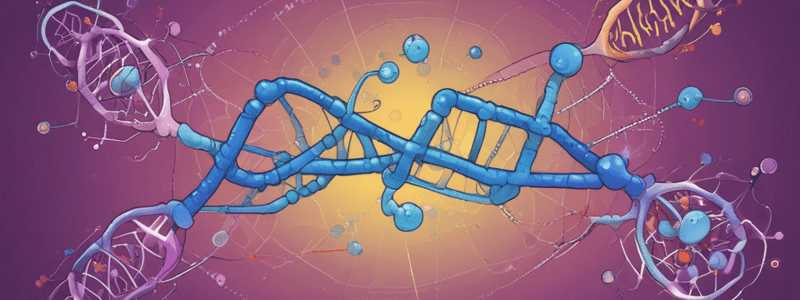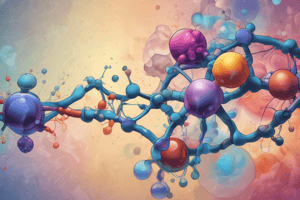Podcast
Questions and Answers
What are the main components of a nucleotide?
What are the main components of a nucleotide?
- Acid + base + sugar
- Sugar + base + phosphate backbone (correct)
- Base + phosphate + lipid
- Base + acid + sugar
Which nucleic acid is primarily responsible for the storage of genetic information?
Which nucleic acid is primarily responsible for the storage of genetic information?
- DNA (correct)
- tRNA
- mRNA
- rRNA
What kind of bond links nucleotide subunits together?
What kind of bond links nucleotide subunits together?
- Hydrogen bond
- Ionic bond
- Peptide bond
- Phosphodiester bond (correct)
Adenine forms hydrogen bonds with which nitrogenous base?
Adenine forms hydrogen bonds with which nitrogenous base?
Which nucleic acid is involved in the regulation of gene expression?
Which nucleic acid is involved in the regulation of gene expression?
How many hydrogen bonds are formed between cytosine and guanine?
How many hydrogen bonds are formed between cytosine and guanine?
Flashcards are hidden until you start studying
Study Notes
Nucleotides
- Consist of sugar, base, and phosphate backbone
- Perform various functions:
- Provide energy for metabolism (ATP)
- Act as enzyme cofactors (NAD+)
- Involved in signal transduction (cAMP)
Nucleic Acids
- Store genetic information (DNA)
- Transmit genetic information (mRNA)
- Process genetic information (ribozymes)
- Synthesize proteins (tRNA and rRNA)
- Regulate expression (siRNA and miRNA)
Structure of DNA
- Composed of two chains of nucleotides coiled around each other in a right-handed double helix
- Sugar-phosphate backbones spiral around the outside of the helix
- Nitrogenous bases extend into the centre at right angles to the axes of the helix
Nucleotide Linkage
- Nucleotide subunits are linked together by phosphodiester bonds
Hydrogen Bonding
- A non-covalent attraction that maintains the double helix structure
- Adenine forms 2 hydrogen bonds with thymine (A=T)
- Cytosine forms 3 hydrogen bonds with guanine (G=C)
- This hydrogen bonding pattern is called base pairing
Studying That Suits You
Use AI to generate personalized quizzes and flashcards to suit your learning preferences.




